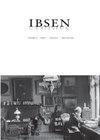Review
IF 0.1
0 THEATER
引用次数: 21
Abstract
The main theme of Olivia Noble Gunn’s study is well summarized in its title: Empty Nurseries, Queer Occupants: Reproduction and the Future in Ibsen’s Late Plays. The empty nurseries that Gunn has found to occupy a conspicuous place in Hedda Gabler (1890), The Master Builder (1892), and Little Eyolf (1894) are not filled with the parents’ children but with what she calls “improper occupants,” i.e., with “inhabitants that are not the children of the family” (16), and she sets out to demonstrate what this recurrent pattern may mean. As a starting point, her observation seems both refreshingly concrete and full of promise. Still, one wonders, at the outset, whether the nursery theme will yield enough material to fill an entire book, not least because, as Gunn herself points out, these empty rooms do not get much attention in the texts: “In a certain sense, Ibsen’s nurseries are little more than traces” (12), they are offstage, and they are “more or less peripheral to the action” (11). However, she maintains that it is precisely these “trace-like qualities” that make the rooms significant; the empty spaces are spaces of possibility and hence of the future (12). A study of this motif may therefore be able to put us on the trail of Ibsen’s thinking about “reproduction in its broad sense” (3). In addition, Gunn maintains that her examination will put her in dialogue with “some major claims from queer and critical child studies” (2). Unfortunately, it is not entirely clear what these claims imply. From the very start, the reader encounters the difficulty of not knowing exactly for whom the study is written. Its style is often评审
奥利维亚·诺布尔·冈恩研究的主题在标题中得到了很好的总结:《空的托儿所》、《酷儿的占有者:易卜生晚期戏剧中的再现与未来》。Gunn发现,在Hedda Gabler(1890)、The Master Builder(1892)和Little Eyolf(1894)中,空荡荡的托儿所占据了显眼的位置,里面不是父母的孩子,而是她所说的“不当占用者”,即“非家庭子女的居民”(16),她试图证明这种反复出现的模式可能意味着什么。作为一个起点,她的观察似乎既令人耳目一新,又充满希望。尽管如此,一开始人们还是想知道,托儿所的主题是否会产生足够的材料来填满整本书,尤其是因为,正如冈恩自己所指出的,这些空房间在文本中没有得到太多关注:“在某种意义上,易卜生的托儿所只不过是痕迹”(12),它们在舞台外,而且“或多或少是活动的外围”(11)。然而,她坚持认为,正是这些“痕迹般的品质”使房间变得重要;空的空间是可能的空间,因此是未来的空间(12)。因此,对这一主题的研究可能会使我们走上易卜生关于“广义再生产”的思考之路(3)。此外,Gunn坚持认为,她的考试将使她与“酷儿和批判性儿童研究的一些主要主张”进行对话(2)。不幸的是,目前还不完全清楚这些说法意味着什么。从一开始,读者就很难确切地知道这项研究是为谁写的。它的风格经常
本文章由计算机程序翻译,如有差异,请以英文原文为准。
求助全文
约1分钟内获得全文
求助全文

 求助内容:
求助内容: 应助结果提醒方式:
应助结果提醒方式:


